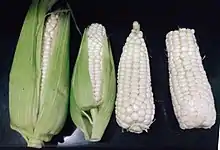Cacahuazintle
"Cacahuazintle" or "cacahuacintle" (Spanish, /kakawa'sintle/; Náhuatl "cacahuacentli" 'pineapple-cocoa cob/cacao-like corn', from "cacahuatl" 'cacao' and "centli" or "cintli" 'corn on the cob')[1] is the name of an old heirloom variety of white dent maize (corn) originating in Toluca, Mexico.[2] It has a large ear with grains that are more white, round, and tender than the typical field corn grain. The dried grains are soaked and/or cooked in water with lime or wood ash, then rinsed thoroughly to remove the outer seed coat as well as any traces of the alkali salts (from the lime or ash)—this is an ancient process called nixtamalization. This creates a fresh, wet hominy, which can be dried for later use or ground into a flour called masa. Masa can be used to make tortillas, tamales, atole, pozole, etc.[1]

When boiling the grains, they open and a loose foam appears. Historically, the primary use of cacahuazintle grain has been in the Mexican dish pozole.[1] The Náhuatl name pozole, or pozolli, means sparkling, probably from the foam produced when cooking this type of corn.[3]
Cacahuazintle can also be distilled into liquor. In Mexico, Abasolo Distillery and Winery (Destilería y bodega Abasolo) produces a whiskey distilled from cacahuazintle corn,[4] also known as pozolero.[5]
Cacahuazintle corn is said to have been in use for a very long time (and still is) as a prized variety for nixtamalization. It is difficult to find seed to grow it in the United States, but it can be found in just a few places on the internet. It is a dent corn. The grain is principally cultivated in the Mexican states of México y Morelos,[6] and in 2020, production reached 23,706 tons.[6] According to Mexico's Ministry of Agriculture and Rural Development, cacahuazintle is registered by the National Commission for the Knowledge and Use of Biodiversity (CONABIO) for "its sweet flavor, smooth texture, floury consistency and large grain."[6]
References
- "Inicia la temporada del elote Cacahuazintle". Gobierno de Mexico (in Spanish). July 5, 2019. Retrieved 6 March 2022.
- @CIMMYT (September 3, 2018). "Cacahuazintle or Cacahuacintle is a native #maize variety from the Valley of #Toluca, #Mexico. Its large kernels that are used to make a traditional soup called #pozole, and ground into a flour for #tortillas, #tamales and #atole. #cimmyt #nativemaize #corn #maizemonday #maiz" (Tweet) – via Twitter.
- Allen, Peter (1 March 2019). "Burritos vs Chimichanga vs Enchiladas - The Key Difference". On the Gas. Retrieved March 9, 2020.
- Denis, Matthew (11 October 2021). "Mexican Corn Elicits Sweet and Smoky at Abasolo Distillery". The Manual. Retrieved 5 March 2022.
- GOMEZ ROQUERO, MARIELA (26 February 2022). "Abasolo,un whisky mexicano de maíz criollo cacahuazintle". Milenio (in Mexican Spanish). Jilotepec, Mexico State. Retrieved 5 March 2022.
- Redacción Ángulo 7 (14 September 2021). "Maíz cacahuazintle, alma del pozole; conoce datos de este grano". Ángulo 7 (in Spanish). Retrieved 5 March 2022.